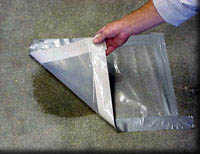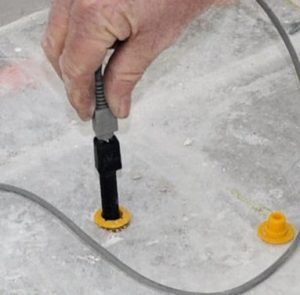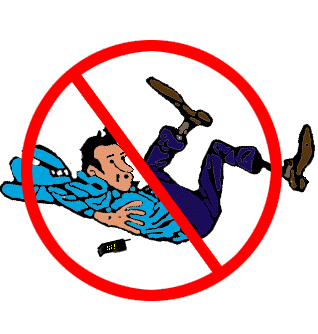Moisture Testing Services:
Slip Free Systems will provide testing services and a moisture test report. The report includes possible causes and solutions using the calcium chloride method for a fee in the Houston Metro Area.
Common Testing Methods and Metering Devices
 Plastic Sheet Method: This is something you can do yourself, it will not give you a numerical reading but it will confirm or deny the presence of water in your slab.
Plastic Sheet Method: This is something you can do yourself, it will not give you a numerical reading but it will confirm or deny the presence of water in your slab.
Securely tape an 18″ x 18″ square of clear plastic on all 4 sides over the concrete in an area where you suspect a moisture problem. We recommend that you test two or more areas of the slab in question for optimal results. Wait 16-24 hours. Check for condensation. If condensation is found on the underside of the plastic or on the concrete, then you have moisture vapor transmission. It is important to note that not all tests by this method will be an effective sign of issues in your slab. This test is highly dependent on outside conditions such as rain, temperature control, humidity, ground water table, and other factors.
In cooler temperatures (ambient/air or surface) the concrete may retain its moisture and fail to build up under the plastic. In warmer temperatures like we have here in Texas the moisture could actually shrivel up and die from heat exhaustion during hot dry months or it could flourish is wet rainy months. This test should be used with caution. This test should be used as a general means of determining whether or not to proceed with moisture vapor transmission options.
Calcium Chloride Test:
The Calcium Chloride Test is just a little bit more technical. This test measures the degree of water vapor emission rising out of a concrete slab over a short period of time. Contractors and architects frequently require this type of test on construction projects before moving forward with floor covering installations. Here at Slip Free we administer the test for a variety of customers. Testing by this method will provide readings, as related to pounds of moisture/vapor being emitted out 1,000 square foot of concrete during a 24-hour period.
The industry norm dictates that the moisture/vapor emission rate should not exceed 3 lbs. per 1000 square foot. It is important to note that moisture vapor testing is based on moisture content of the slab at the time of testing. Taking the same test during a different season of the year or even a few weeks later could produce different results. This is why as a homeowner it is important for you to be watchful of the telltale signs of floor moisture in your home.
IMPORTANT NOTE: Moisture testing will only give you an indication of moisture content at the time of the test. If your atmospheric conditions change your moisture transmission and pressure will also change. Your pressure could go up or down. The test is just to confirm the existence of a problem and cannot identify future conditions.
ASTM Standards & Practices for Calcium Chloride Testing:
E-1907-97 Standard Practice for Determining Moisture-Related Acceptability of Concrete Floors to Receive Moisture-Sensitive Finishes
E-1869-03 Standard Test Method for Measuring Moisture Vapor Emission Rate of Concrete Sub-floor Using Anhydrous Calcium Chloride
E-l907-97 Document describes all the major tests commonly used for concrete floor slab testing (which includes the Calcium Chloride Test)
Electronic Moisture Meters:

Probe test to determine moisture deep within your slab.
These meters read moisture content immediately. Detects moisture beneath the surface by measuring the resistance between two low frequency signals transmitted from conductive pads on the base of the instrument. These meters, like other testing methods are dependent on environmental conditions.
Another method is to drill a hole in the concrete and place a special plug in it. The probe of a humidity gauge is inserted into the plug and left to stabilize for 12 hours. RH reading is taken. The advantage of this method is that the RH measurement is not effected by sealers, curing agents, or coatings on the concrete. This method is dependent on moisture content at the time of testing and cannot provide results for long periods or over time.
Typical signs of rising moisture/vapor problems:
Excessive rising moisture being emitted from bare concrete typically exhibits itself on sealed surfaces in the form of efflorescence. Efflorescence manifests itself in the appearance of little while puffy clouds that sit on your surface.
Another sign of moisture vapor transmission is the musky, moldy or stale scent present in the room. This happens particularly in small spaces like closets, in cabinets or under shelving.
On floors where a coating has been installed signs of moisture vapor includes outgassing, blistering, pealing, loss of clarity, darkening of substrate beneath sealer, efflorescence issues, and total bond failure. On floor where a covering has been installed it can result in mold and rot and buckling under the floor covering.
Water will transmit to the surface when there is higher vapor pressure in the concrete than in the air above the surface. This condition is more apt to occur when the air conditioning is first turned on in a new building. It is best to allow the air in the building to stabilize for a minimum of 24 hours before sealing an interior surface.
Conclusion
Moisture in your slab can cause failure of your floor coating and/or floor covering (carpet, tile, etc), the structure of your house and even your health. In many cases you can slow down or completely stop moisture vapor transmission in the slab with the right product and treatment. Some floors exhibit an issue greater than modern technology is prepared for. In some very aggressive moisture vapor transmission conditions, you may be able to file a claim with your Home Warranty or insurance.
At Slip Free Systems we do our best to offer you advice based on our years of experience and training. Once informed, we defer to the customer to make the best decision for them based on their needs and budget. Moisture retarders are to HELP ALEVIATE moisture from penetrating your slab and creating a moisture hazard under your furnishings.
There is no known, fail proof, method or coating that will eliminate moisture conditions in your slab 100% of the time or area of your issue. If your home was built prior to 1984 and you are on the Texas Gulf Coast, a moisture treatment should be considered as an option to SLOW DOWN moisture mitigation. It should not be expected to eliminate the problem 100% under any circumstances.
Click here to return to our home page.



